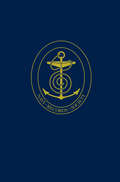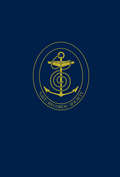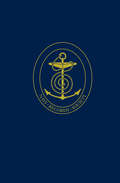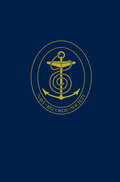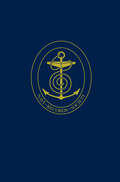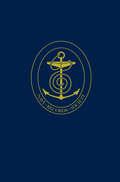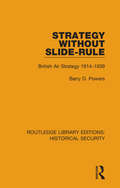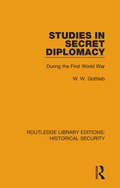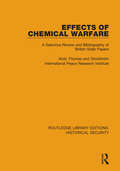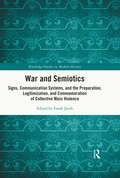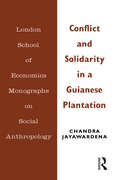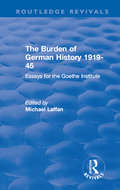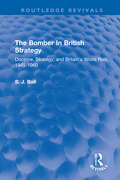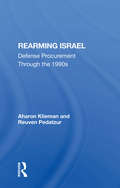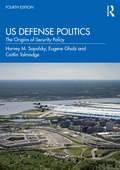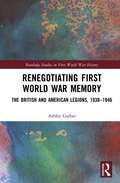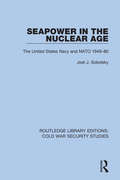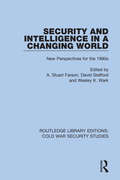- Table View
- List View
The Rodney Papers: Volume I, 1742–1763: Selections from the Correspondence of Admiral Lord Rodney
by David SyrettOverbearing, avaricious and difficult, yet talented and ambitious, George Brydges Rodney has never attracted much sympathy or understanding. He was nevertheless an original thinker and one of the great admirals of the eighteenth century. The contents of this volume, the first of three, document his career from 1742 until 1763 - his private and political life. His early years as a captain were spent in the severe conditions of the North Sea and in taking privateers in the western approaches. During the peace after 1748 he was Governor of Newfoundland and in the Seven Years' War blockaded Le Havre before going, as a flag officer, to command in the Leeward Islands where he participated in the capture of Martinique. This volume also contains letters to his wife which indicate, against past opinion, that Rodney had a heart.
The Maritime Blockade of Germany in the Great War: The Northern Patrol, 1914-1918
by John D. GraingerThe Tenth Cruiser Squadron of the Grand Fleet had the task of patrolling the seas between Scotland and Greenland to intercept enemy ships trying to escape into the ocean and merchant ships who could be carrying goods destined for Germany. This was a task of great political sensitivity, since almost all the ships intercepted were neutrals, and requiring great physical endurance from ships and men in the violent North Atlantic. The Maritime Blockade of Germany in the Great War is a comprehensive collection of the records of the Northern Patrol. It consists of regular reports of the admirals in command, to which are added other relevant official records, and more informal documents. There are the chatty letters of Captain Vivian and HMS Patia, the appalling experiences of young officers placed in barely seaworthy sailing ships to see that they went into port for examination, the patehtic 'mutiny' by a bored, distressed and underpaid black gang, the diary of Able Seaman Style, demonstrating the tedium of the patrol, and the self-satisfied diary of Dr Shaw. There are also the casualities: ships overwhelmed by storms, sunk by enemy action, torpedoed. The ships of the Patrol were perhaps the most constantly active Royal Navy vessels in the Great War, a barely acknowledged yet vital component in the eventual Allied victory
The Submarine Service, 1900–1918
by Nicholas LambertThe year 2001 marks the centenary of the Royal Navy's submarine service. In the aftermath of the 2016 celebrations of the Battle of Jutland centenary, it is worth considering how the First World War at sea changed. This volume opens with an examination of the background to the Board of Admiralty's decision in 1900 to buy submarines, bringing to light documents that go a long way toward dispelling the myth that Britain's pre-1914 naval leaders were opposed to the development of the submarine as a major weapon. Indeed, the documents show that senior naval officers and influential civilians in Whitehall believed that the advent of the submarine would revolutionize naval warfare in a way that would bolster the Royal Navy's position as the world's predominant naval power. This edited selection of documents illustrates not only the Admiralty's thinking on the employment of the submarine between 1900 and 1918, it also charts the technical development of British submarines, and explains issues such as why the pioneer submariners came to regard themselves as an élite group within the Royal Navy - and were allowed to become the 'silent service'.
The Royal Navy in River Plate 1806–1807
by John D. GraingerThis book presents a collection of contemporary documents throwing light on the campaigns by the Royal Navy, in association with the army, on cities of the Spanish Empire in South America, beginning with the (unauthorised) assault on Buenos Aires in 1806, by Sir Home Popham. One of Popham’s aims was to open South America for British trade and also perhaps to liberate the land from its supposed Spanish oppressors, and although the people of Buenos Aires may not have wished to remain as Spanish subjects, it soon became apparent that they had no wish to become British subjects. It was this fact that led to the subsequent loss of Buenos Aires only six weeks after its capture, and the net result of Popham’s interventions was to begin the process of South American independence and the collapse of the Spanish Empire.
Expedition of Sir John Norris and Sir Francis Drake to Spain and Portugal, 1589
by R.B. WernhamActions against the Spanish Armada and campaigns in the Netherlands left the Queen’s coffers empty. For this reason proposals to capture the Spanish treasure fleet were given royal support. The treasure fleet homeward bound from the Americas would be intercepted in the Azores. A diversion at Santander to damage the Spanish fleet would prevent protection of the treasure fleet and, more importantly, prevent further actions against England or Ireland. However, the project was diverted further with backers wanting to re-instate Don Antonio as King of Portugal, with ideas of gaining lucrative Portuguese trade rights.At sea a further diversion was taken, with news of shipping at Corunna and the prospect of capturing merchantmen. ‘Profit was already challenging strategy’. This diversion gave their enemies more time to prepare. The failure at Lisbon was partly from a lack of co-ordination between the navy and army but also from the lack of promised support from Don Antonio’s supporters.The decision to sail for the Azores to intercept the Spanish treasure fleet was at last made only for Drake to be driven back to England by a storm. Short of supplies and with sick crews the ships were in no condition to continue with the Queen’s demands so there was no great treasure and the Spanish fleet was still in being. The sale of prizes and their contents failed to cover the cost of the expedition, and so the expedition was considered a financial and strategic failure.
The Collective Naval Defence of Empire, 1900–1940
by Nicholas TracyThis collection of high policy documents charts Britain’s difficulties in defending the Empire in a time of ’imperial overstretch’. The 20th century saw the rise of several great maritime and military powers and the relative decline of British strength, which created major defence problems for the British Empire. Various solutions were attempted, such as ententes with France and Russia, the settling of differences with the USA and an alliance with Japan. These sufficed until after World War I, when the Empire gained several new territorial responsibilities, all to be defended on a declining economic base. The dominions were encouraged to pay for their own navies, although the Admiralty wished to assume control of them. The increasing threat from Japan made Australia, New Zealand and other Asian colonies nervous and the promised ’main fleet to Singapore’ became less and less likely as the 1930s wore on.
Strategy Without Slide-Rule: British Air Strategy 1914–1939 (Routledge Libary Editions: Historical Security)
by Barry D. PowersThe early history of British aerial defence development is one of misdirection and delusion. The misdirection, judging by the criteria of successful aerial defence in World War II, was primarily in the downgrading of home defence measures including the fighter plane. The delusion, again judging by Britain’s efforts in that second world war, was primarily in the assumption of the effects to be obtained by strategic bombing. In both cases, the First World War was a major catalyst. Although events and writings before that war indicate the coming patterns, it was during that war that a great amount of the patterns are well established. Originally published in 1976, this work explores these origins and stresses the interaction between various diverse segments of English society in the formation of the major patterns. The working out of these patterns in the first half of the interwar years is also analysed, again with respect to diverse groupings in Britain.
Studies in Secret Diplomacy: During the First World War (Routledge Libary Editions: Historical Security)
by W. W. GottliebOriginally published in 1957, the original blurb reads: ‘From these studies of the secret diplomacy surrounding the entry of Turkey and Italy into the First World War, emerges a picture of the complex machinery behind the obvious wheels of international politics. The activities of statesmen and diplomats are related to the ramifications of big business, banks, oil and armament companies. The story of each move and counter-move, told mostly in the actors’ own words and with many quotations from actual memoranda and dispatches, is based on sources which are quite new. The Russian collections of confidential correspondence, which include foreign diplomatic dispatches intercepted and deciphered in Russia, and the latest Documenti Diplomatici Italiani are practically unknown to the British public. This material has been integrated with that taken from all the available collections of British, French, German, Austro-Hungarian and American diplomatic documents, official publications, contemporary periodicals and economic and financial data, and such mines of information as the diaries, recollections and private letters of those involved. This unusual combination of source material allows some general conclusions to be drawn as to the laws and logic of the diplomacy of power politics. The most striking fact, perhaps, is the diplomatic war among allies. The book brings out the deep-seated conflicts of interests in the German-Austro-Hungarian coalition, and those dividing Britain, France, Russia and Italy in the Near East, the Balkans and the Mediterranean. Another point of special interest is the inter-group and party struggle inside the countries for or against war; and another is the genesis of some of the fateful Secret Treaties which bedevilled the peace settlements of 1919-20.’ Today it can be read and enjoyed in its historical context.
Strategy Without Slide-Rule: British Air Strategy 1914–1939 (Routledge Libary Editions: Historical Security)
by Barry D. PowersThe early history of British aerial defence development is one of misdirection and delusion. The misdirection, judging by the criteria of successful aerial defence in World War II, was primarily in the downgrading of home defence measures including the fighter plane. The delusion, again judging by Britain’s efforts in that second world war, was primarily in the assumption of the effects to be obtained by strategic bombing. In both cases, the First World War was a major catalyst. Although events and writings before that war indicate the coming patterns, it was during that war that a great amount of the patterns are well established. Originally published in 1976, this work explores these origins and stresses the interaction between various diverse segments of English society in the formation of the major patterns. The working out of these patterns in the first half of the interwar years is also analysed, again with respect to diverse groupings in Britain.
Studies in Secret Diplomacy: During the First World War (Routledge Libary Editions: Historical Security)
by W. W. GottliebOriginally published in 1957, the original blurb reads: ‘From these studies of the secret diplomacy surrounding the entry of Turkey and Italy into the First World War, emerges a picture of the complex machinery behind the obvious wheels of international politics. The activities of statesmen and diplomats are related to the ramifications of big business, banks, oil and armament companies. The story of each move and counter-move, told mostly in the actors’ own words and with many quotations from actual memoranda and dispatches, is based on sources which are quite new. The Russian collections of confidential correspondence, which include foreign diplomatic dispatches intercepted and deciphered in Russia, and the latest Documenti Diplomatici Italiani are practically unknown to the British public. This material has been integrated with that taken from all the available collections of British, French, German, Austro-Hungarian and American diplomatic documents, official publications, contemporary periodicals and economic and financial data, and such mines of information as the diaries, recollections and private letters of those involved. This unusual combination of source material allows some general conclusions to be drawn as to the laws and logic of the diplomacy of power politics. The most striking fact, perhaps, is the diplomatic war among allies. The book brings out the deep-seated conflicts of interests in the German-Austro-Hungarian coalition, and those dividing Britain, France, Russia and Italy in the Near East, the Balkans and the Mediterranean. Another point of special interest is the inter-group and party struggle inside the countries for or against war; and another is the genesis of some of the fateful Secret Treaties which bedevilled the peace settlements of 1919-20.’ Today it can be read and enjoyed in its historical context.
Effects of Chemical Warfare: A Selective Review and Bibliography of British State Papers (Routledge Libary Editions: Historical Security)
by Andy Thomas Stockholm International Peace Research InstituteOriginally published in 1985, this book is the result of an exploration of the state papers of the United Kingdom undertaken with the aim of discovering information about the past use of chemical warfare. This information may serve as a point of historical reference in speculation upon the possible nature and consequences of large-scale chemical warfare recurring in Europe. Part I of the monograph concentrates primarily on material documenting the use of chemical weapons in the First and Second World Wars, the impact of this use on the civilian populations of France and Belgium, casualties incurred in the production, research, development, training and deployment of chemical warfare agents, and the attempts made to incorporate chemical weapons into military doctrine and war-preparedness. Part II supplements the citation of documents in Part I. It comprises an ordered bibliography listing not only the location of the records found to be of primary concern to this study, but also the location of other records not cited in Part I which appear to form much of the remainder of the official record of the British CW effort. A list of some of the papers which have not been released comprises the concluding section.
Effects of Chemical Warfare: A Selective Review and Bibliography of British State Papers (Routledge Libary Editions: Historical Security)
by Andy Thomas Stockholm International Peace Research InstituteOriginally published in 1985, this book is the result of an exploration of the state papers of the United Kingdom undertaken with the aim of discovering information about the past use of chemical warfare. This information may serve as a point of historical reference in speculation upon the possible nature and consequences of large-scale chemical warfare recurring in Europe. Part I of the monograph concentrates primarily on material documenting the use of chemical weapons in the First and Second World Wars, the impact of this use on the civilian populations of France and Belgium, casualties incurred in the production, research, development, training and deployment of chemical warfare agents, and the attempts made to incorporate chemical weapons into military doctrine and war-preparedness. Part II supplements the citation of documents in Part I. It comprises an ordered bibliography listing not only the location of the records found to be of primary concern to this study, but also the location of other records not cited in Part I which appear to form much of the remainder of the official record of the British CW effort. A list of some of the papers which have not been released comprises the concluding section.
War and Semiotics: Signs, Communication Systems, and the Preparation, Legitimization, and Commemoration of Collective Mass Violence (Routledge Studies in Modern History)
by Frank JacobWars create their own dynamics, especially with regard to images and language. The semiotic and semantic codes are redefined, according to the need to create an enemy image, or in reference to the results of a war that are post-event defined as just or reasonable. The semiotic systems of wars are central to the discussion of the contributions within this volume, which highlight the interrelationship of semiotic systems and their constructions during wars in different periods of history.
War and Semiotics: Signs, Communication Systems, and the Preparation, Legitimization, and Commemoration of Collective Mass Violence (Routledge Studies in Modern History)
by Frank JacobWars create their own dynamics, especially with regard to images and language. The semiotic and semantic codes are redefined, according to the need to create an enemy image, or in reference to the results of a war that are post-event defined as just or reasonable. The semiotic systems of wars are central to the discussion of the contributions within this volume, which highlight the interrelationship of semiotic systems and their constructions during wars in different periods of history.
Conflict and Solidarity in a Guianese Plantation (LSE Monographs on Social Anthropology)
by Chandra JayawardenaThis study concerns two communities of sugar plantation labourers, the descendants of indentured immigrants from India, who live in the county of Berbice, British Guiana. The study is focused on the analysis of social conflict: the factors that cause it, the forms it takes and its social consequences.
Conflict and Solidarity in a Guianese Plantation (LSE Monographs on Social Anthropology #Vol. 25)
by Chandra JayawardenaThis study concerns two communities of sugar plantation labourers, the descendants of indentured immigrants from India, who live in the county of Berbice, British Guiana. The study is focused on the analysis of social conflict: the factors that cause it, the forms it takes and its social consequences.
The Burden of German History 1919-45: Essays for the Goethe Institute (Routledge Revivals)
by Michael LaffanOriginally published in 1988, The Burden of German History 1919-45 examines the vast literature surrounding Weimar years and the National Socialist tragedy, daunting even for the specialist historian or political scientist. The essays included in this volume provide an invaluable guide to research of the time and provides a stimulating review of a wide range of topics in modern German cultural, political, economic and military history. The essays are based on a series of lectures given by German and Irish scholars to a conference on the theme ‘Weimar Germany and National Socialism’, which was held in March 1986 in University College, Dublin, under the auspices of the Goethe Institute, Dublin. This book offers a significant commentary on a period of German history which included the exciting and ambivalent freedom of the Weimar society and the repressive, murderous uniformity of National Socialism.
The Bomber In British Strategy: Doctrine, Strategy, and Britain's World Role, 1945-1960 (Routledge Revivals)
by S. J. BallBetween 1945 and 1960, Great Britain constructed a substantial nuclear-armed bomber force. The creation of this force had ramifications that extended well beyond the confines of military policy. The process played a large part in defining relations with the United States, and the belief that these bombers could replace conventional forces convinced successive British governments that Great Britain could maintain a significant global military role. Originally published in 1995 and drawing on both archives and oral testimony, this book analyses British strategic discourse and its influence on British foreign policy in the early decades of the Cold War.
Rearming Israel: Defense Procurement Through The 1990s
by Aharon Klieman Reuven PedatzurThis study analyzes the key functions of arms planning and procurement in the ongoing Israeli defence effort. Part I addresses individual constraints placed on the shaping of arms control policy. Part II asks how Israel might best meet its arms needs over the next decade.
US Defense Politics: The Origins of Security Policy
by Harvey M. Sapolsky Eugene Gholz Caitlin TalmadgeThis book provides an accessible overview of US defense politics for upper-level students. This new edition has been updated and revised, with new material on the Trump Administration and Space Force. Analyzing the ways in which the United States prepares for war, the authors demonstrate how political and organizational interests determine US defense policy and warn against over-emphasis on planning, centralization, and technocracy. Focusing on the process of defense policy-making rather than just the outcomes of that process, US Defense Politics departs from the traditional style of many textbooks. Designed to help students understand the practical side of American national security policy, the book examines the following key themes: US grand strategy; the roles of the president and the Congress in controlling the military; organizational interests and civil-military relations; who joins America's military; what happens to veterans after wars; how and why weapons are bought; the management of defense and intra- and inter-service relations; public attitudes toward the military; homeland security and the intelligence community. The fourth edition will be essential reading for students of US defense politics, national security policy, and homeland security, and highly recommended for students of US foreign policy, public policy, and public administration.
US Defense Politics: The Origins of Security Policy
by Harvey M. Sapolsky Eugene Gholz Caitlin TalmadgeThis book provides an accessible overview of US defense politics for upper-level students. This new edition has been updated and revised, with new material on the Trump Administration and Space Force. Analyzing the ways in which the United States prepares for war, the authors demonstrate how political and organizational interests determine US defense policy and warn against over-emphasis on planning, centralization, and technocracy. Focusing on the process of defense policy-making rather than just the outcomes of that process, US Defense Politics departs from the traditional style of many textbooks. Designed to help students understand the practical side of American national security policy, the book examines the following key themes: US grand strategy; the roles of the president and the Congress in controlling the military; organizational interests and civil-military relations; who joins America's military; what happens to veterans after wars; how and why weapons are bought; the management of defense and intra- and inter-service relations; public attitudes toward the military; homeland security and the intelligence community. The fourth edition will be essential reading for students of US defense politics, national security policy, and homeland security, and highly recommended for students of US foreign policy, public policy, and public administration.
Renegotiating First World War Memory: The British and American Legions, 1938–1946 (Routledge Studies in First World War History)
by Ashley GarberFirst World War-based ex-servicemen’s organisations found themselves facing an existential crisis with the onset of the Second World War. This book examines how two such groups, the British and American Legions, adapted cognitively to the emergence of yet another world war and its veterans in the years 1938 through 1946. With collective identities and socio-political programmes based in First World War memory, both Legions renegotiated existing narratives of that war and the lessons they derived from those narratives as they responded to the unfolding Second World War in real time. Using the previous war as a "learning experience" for the new one privileged certain understandings of that conflict over others, inflecting its meaning for each Legion moving forward. Breaking the Second World War down into its constituent events to trace the evolution of First World War memory through everyday invocations, this unprecedented comparison of the British and American Legions illuminates the ways in which differing international, national, and organisational contexts intersected to shape this process as well as the common factors affecting it in both groups. The book will appeal most to researchers of the ex-service movement, First World War memory, and the cultural history of the Second World War.
Renegotiating First World War Memory: The British and American Legions, 1938–1946 (Routledge Studies in First World War History)
by Ashley GarberFirst World War-based ex-servicemen’s organisations found themselves facing an existential crisis with the onset of the Second World War. This book examines how two such groups, the British and American Legions, adapted cognitively to the emergence of yet another world war and its veterans in the years 1938 through 1946. With collective identities and socio-political programmes based in First World War memory, both Legions renegotiated existing narratives of that war and the lessons they derived from those narratives as they responded to the unfolding Second World War in real time. Using the previous war as a "learning experience" for the new one privileged certain understandings of that conflict over others, inflecting its meaning for each Legion moving forward. Breaking the Second World War down into its constituent events to trace the evolution of First World War memory through everyday invocations, this unprecedented comparison of the British and American Legions illuminates the ways in which differing international, national, and organisational contexts intersected to shape this process as well as the common factors affecting it in both groups. The book will appeal most to researchers of the ex-service movement, First World War memory, and the cultural history of the Second World War.
Seapower in the Nuclear Age: The United States Navy and NATO 1949-80 (Routledge Library Editions: Cold War Security Studies #41)
by Joel J. SokolskyThis book, first published in 1991, provides a major analysis of the prelude to the US’s Cold War maritime strategy, showing how NATO’s maritime forces were organised in the period. It examines how the United States Navy and allied navies, particularly the Royal Navy, were incorporated into the Alliance’s nuclear and conventional deterrent forces. It looks at the structure of the main naval commands, the growth of Soviet maritime forces and the impact of the flexible response strategy on NATO’s naval posture in the 1970s. Drawing upon many declassified documents, this account fills an important gap in postwar literature on American seapower and its relation to European security. It also addresses important aspects of NATO strategy and organisation.
Security and Intelligence in a Changing World: New Perspectives for the 1990s (Routledge Library Editions: Cold War Security Studies #43)
by A. Stuart FarsonThis book, first published in 1991, examines the changes to security and intelligence agencies envisioned in the uncertain world at the end of the Cold War. While the central focus is on the Canadian Security Intelligence Service, its history, function and future, there are also comparative studies of the British, Soviet, American and Australian systems.
